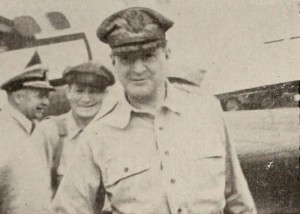
"When Lewis B. Sebring. jr., went from the United States early in 1942. as a war correspondent accredited to General Douglas MacArthur's headquarters, he wisely left his camera at home. There was no telling what dangers and difficulties lay ahead. Months later, after the Japanese had been driven back across the Owen Stanley Mountains, after the battles of Buna, Salamaua and others, there seemed to be more time and opportunity for personal movie making. Happily, Mr. Sebring managed to borrow a good 16mm. camera, and New Guinea Newsreel is one of the exciting results. Keyed by the expert titles of a news writer, it presents a series of well rounded sequences on such colorful subjects as a visit by General MacArthur; a cine interview with Major Richard I. Bong, top American air ace of the war to date; an informal exhibition of Japanese souvenirs, and a moving Easter service, somber against the gray dawn of a New Guinea foreshore." Movie Makers, Dec. 1944, 496.
"a war film… deals principally with submarines… an almost full-sized submarine was built out of sheet-iron and wood; the very convincing interior of the aforesaid submarine was built in a garage; and merchant ships (models) were ruthlessly blown up by a torpedo (ditto, bought at Woolworths), which zipped through the water (by a string wound on a Kodak rewind) and left a wicked-looking wash (milk)" (R.S. 1932: 9).
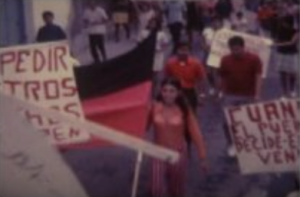
"El guión tenía una fuerte influencia de La hora de los hornos, y tendía a la explicación pedagógica de las condiciones de opresión, mostrando la diferencia entre la forma de vida de ricos y pobres y con una explicación sencilla de cómo el capitalismo sienta las bases de una explotación que finalmente es la base de las razones de la huelga [El filme muestra la huelga de Rivetex en Cuernavaca] . El título de la película (Nosotros sí existimos) jugaba con el término legal que había declarado la huelga inexistente" (Vázquez Mantecón, 2012). "The script had a strong influence of The hour of the furnaces , and it tended to a pedagogical explanation of the conditions of oppression, showing the difference between the way of life of the rich and the poor, along with a simple explanation of how capitalism sets the basis for exploitation, which is the origin of the strike [The film portrays the Rivetex strike in Cuernavaca]. The title of the film [We do exist] played with the legal term that had declared the strike non-existent" (Vázquez Mantecón, 2012).
documentary chronicle about the Gruppi Universitari Fascisti (GUF) female championship in Rome, September 1937
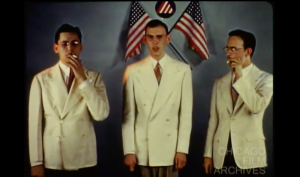
"Three men encourage people to follow rules set by the air raid warden in the event of an air raid. The rules are put to song, and some rules are depicted by actors." Chicago Film Archives
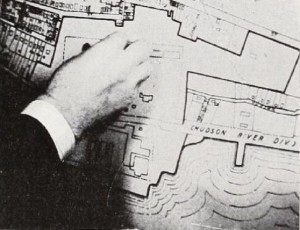
"Ossining in Wartime is a sincere cinematic record of civilian war activities which every community in the land would be pleased and proud to have. It was not an easy production to complete. Conceived only in the later years of our war effort, the majority of the picture's sequences had to be especially recreated for the ubiquitous camera of its producer, Robert F. Gowen. Newspaper headlines, posters, placards and an occasional subtitle maintain the film's episodic continuity from the earliest efforts of airplane spotters and air wardens to the final joyous ceremonies marking victory over Germany and Japan." Movie Makers, Dec. 1945, 496.
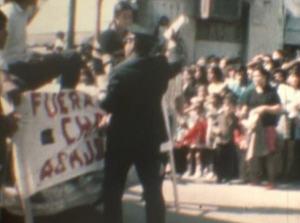
"En este cortometraje se narra la resistencia al régimen en la ciudad de Monterrey, en el estado de Nuevo León, a través de varios frentes: la irrupción de un grupo de sindicalistas independientes en el desfile oficial del 20 de noviembre, con la presencia del gobernador Luis M. Farías; la invasión de tierras y la presencia de organizaciones vecinales en Topo Chico; los muertos por un accidente laboral en la Fundidora Monterrey; las huelgas de obreros de la CTM y de panaderos de la CROC (dos poderosos sindicatos oficiales), o la actividad vecinal del Grupo 2 de Octubre en la colonia Días Ordaz" (Vázquez Mantecón, 2012).
"This short film tells the story of the resistance against the regime in Monterrey city, in the state of Nuevo León, through several perspectives: the irruption of a group of independent union laborers in the official November 20th parade, with the presence of governor Luis M. Farías; the invasion of land and the presence of neighborhood organizations in Topo Chico; the dead by a working accident in Fundidora Monterrey [Monterrey Foundry]; the strikes of CTM workers and CROC bakers (two powerful official labor unions), or the activities of neighbors of the October 2 Group in Diaz Ordaz vicinity" (Vázquez Mantecón, 2012).
"Hacía un alegato sobre lo que sucede al otro lado de la tranquilidad de la vida burguesa. Se alternaban imágenes de placidez doméstica de la clase media con escenas de la guerra de Vietnam y las rebeliones estudiantiles de la época. Al final de la cinta, sobre la fotografía de un mitin en Tlatelolco, una pregunta: "saber, darse cuenta, ¿cuándo?" "(Vázquez Mantecón, 2012).
"It was an allegation about what happens at the other side of the bourgeois life tranquility. Images of middle class house placidity were alternated with scenes from the Vietnam war and the students' rebellions of the time. At the end of the film, over the photography of a political rally in Tlatelolco, a question: "to know, to notice, when?" " (Vázquez Mantecón, 2012).
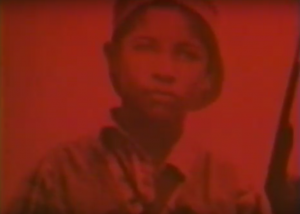
"En Patria Libre, Sergio García documentó los primeros logros de la revolución sandinista en Nicaragua. [...] Se trataba de un documental convencional, con una voz off (leída por Felio Eliel) sobre un momento de frescura y esperanza por el triunfo del Frente Sandinista de Liberación Nacional. El arranque del documental con una serie de imágenes de Sandino en alto contraste que culminan en la foto de un adolescente guerrillero (mientras que en la banda sonora se escucha a Pablo Milanés cantar "Los caminos") preludian el tono que se desarrollará sobre el caso de la revolución sandinista" (Vázquez Mantecón, 2012.)
"In Patria Libre [Free Country], Sergio García documented the first achievements of the Sandinista Revolution in Nicaragua. It was a conventional documentary, with an off voice (read by Felio Eliel) about a moment of freshness and hope because of the triumph of the Sandinista National Liberation Front. The documentary begins with a series of highly contrasted images of Sandino that end with the picture of a guerrilla teenager (while the soundtrack plays "Los caminos" [The roads] by Pablo Milanés), which is a prelude to the tone that will be used to describe the Sandinista Revolution" (Vázquez Mantecón, 2012).
Total Pages: 9